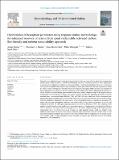Optimization of desorption parameters using response surface methodology for enhanced recovery of arsenic from spent reclaimable activated carbon: Eco-friendly and sorbent sustainability approach

View/
Date
2024-06-05Author
Bayuo, Jonas
Rwiza, Mwemezi
Choi, Joon
Sillanpaa, Mika
Mtei, Kelvin
Metadata
Show full item recordAbstract
Desorption and adsorbent regeneration are imperative factors that are required to be taken into account when
designing the adsorption system. From the environmental, economic, and practical points of view, regeneration
is necessary for evaluating the efficiency and sustainability of synthesized adsorbents. However, no study has
investigated the optimization of arsenic species desorption from spent adsorbents and their regeneration ability
for reuse as well as safe disposal. This study aims to investigate the desorption ability of arsenic ions adsorbed on
hybrid granular activated carbon and the optimization of the independent factors influencing the efficient re-
covery of arsenic species from the spent activated carbon using central composite design of the response surface
methodology. The activated carbon before the sorption process and after the adsorption-desorption of arsenic
ions have been characterized using SEM-EDX, FTIR, and TEM. The study found that all the investigated inde-
pendent desorption variables greatly influence the retrievability of arsenic ions from the spent activated carbon.
Using the desirability function for the optimization of the independent factors as a function of desorption effi-
ciency, the optimum experimental conditions were solution pH of 2.00, eluent concentration of 0.10 M, and
temperature of 26.63 ℃, which gave maximum arsenic ions recovery efficiency of 91 %. The validation of the
quadratic model using laboratory confirmatory experiments gave an optimum arsenic ions desorption efficiency
of 97 %. Therefore, the study reveals that the application of the central composite design of the response surface
methodology led to the development of an accurate and valid quadratic model, which was utilized in the
enhanced optimization of arsenic ions recovery from the spent reclaimable activated carbon. More so, the
desorption isotherm and kinetic data of arsenic were well correlated with the Langmuir and the pseudo-second-
order models, while the thermodynamics studies indicated that arsenic ions desorption process was feasible,
endothermic, and spontaneous.
URI
https://doi.org/10.1016/j.ecoenv.2024.116550https://dspace.nm-aist.ac.tz/handle/20.500.12479/2802
